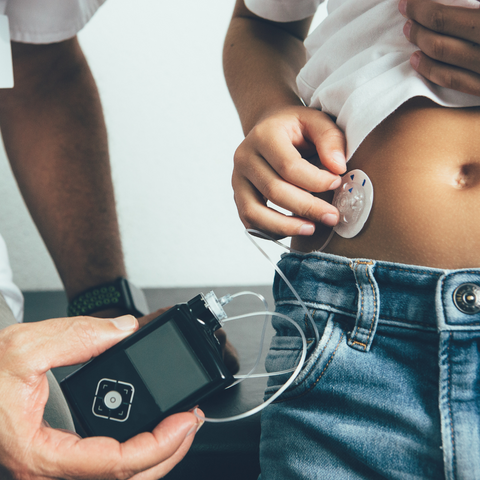What is Insulin? Your Easy-to-Understand Guide

🎧 On the go? Listen to this episode on The GOOD IDEA Audio Blog, available on Shopify or Apple Podcasts.
In the complex world of health and wellness, certain terms are thrown around quite frequently, yet their deep, underlying meanings can often remain shrouded in mystery. One of those terms is "insulin." You've likely heard it in conversations about blood sugar, diabetes, or diet, but what is insulin, exactly? This guide aims to unravel the complexities of insulin, presenting the facts in an easy-to-understand manner. Whether you're someone living with diabetes, a health enthusiast, or simply curious, this guide is tailored for you.
Understanding the Basics of Insulin

Insulin usually works in tandem with glucose, a type of sugar from the foods we eat. When you enjoy a meal, your body gets to work breaking down the carbohydrates into glucose, which then enters the bloodstream and blood sugar rises. This can be a great way to fuel our brain or physical activities. However, the glucose is of little use just floating around in our bloodstream. This is where insulin steps in. When your body senses a rise in glucose the pancreas, located just behind your stomach, releases insulin. Insulin serves as a traffic director for glucose. The insulin grabs glucose and pulls into the appropriate cells, where it can be used as fuel. Without insulin, glucose would just circulate in the bloodstream, unable to power our activities, and leading to an unhealthy imbalance within the body.
This process of glucose absorption is crucial not just for providing energy but also for ensuring that your body's glucose levels stay balanced. If glucose levels get too high, it can lead to serious health issues, which is why insulin's role is so critical. By understanding the basic function of insulin, we gain insight into the importance of maintaining a healthy balance for overall wellness.
The Key Functions of Insulin in the Body

At its core, insulin serves as the body's essential regulator of blood sugar levels, ensuring they remain within a safe range. Picture insulin as a meticulous traffic controller, directing the flow of glucose to prevent it from reaching harmful levels. This hormone signals the liver to store extra glucose, which acts as a reserve fuel that the body can tap into during times when you're not eating or when you're physically active.
But insulin's job doesn't stop with just glucose management; it's also a key player in the metabolism of fats and proteins. This means it influences how your body stores fat and maintains muscle, playing a pivotal role in your overall metabolic health. By helping to convert the food we eat into energy and ensuring that energy is stored and available for when it's needed, insulin supports the body in performing its daily functions efficiently and effectively. This balancing act is crucial for our health, underscoring insulin's vital importance in our body's system.
What Happens When Insulin Levels Are Imbalanced?

Remember how and glucose work together to maintain stable blood sugar levels and shuttle glucose to the appropriate cells? When this balance is disrupted, it leads to conditions like hyperglycemia, where too much glucose stays in the bloodstream due to insufficient insulin or the body's decreased ability to use insulin. This can cause symptoms such as feeling very thirsty, urinating more often than usual, and experiencing an intense hunger.
On the other end of the spectrum is hypoglycemia, which happens when there's too much insulin directing not enough glucose. This can make you feel shaky, sweaty, and irritable or cause sudden mood swings. Both these scenarios show how critical the balance of insulin levels is for our health.
Hyperglycemia and hypoglycemia are like two extremes on a scale, with optimal health lying in the balance. Managing these levels is especially crucial for individuals with diabetes, but understanding this balance is important for everyone. It's all about ensuring the insulin and the glucose are in harmony, allowing our bodies to keep running smoothly.
The Role of Insulin in Diabetes Management

Diabetes throws a wrench into the way our body handles insulin, making the balancing act more complicated. In type 1 diabetes, the body's defense system mistakenly targets cells in the pancreas that make insulin, leading to very low or no insulin production. To bridge this gap, people with type 1 need to take insulin through injections or a pump, integrating it into their daily lives to mimic the natural flow of insulin and maintain blood glucose at healthy levels. Since insulin needs change depending on activity levels, stress, sleep, and food choices, monitoring glucose and administering insulin is an ongoing and highly individualized process for people with type 1 diabetes.
For those with type 2 diabetes, the challenge is slightly different. The body still produces insulin but isn't as effective at using it, a condition known as insulin resistance. Type 2 diabetes is usually diagnosed later in life because it occurs due to consistently elevated blood sugar levels. When our blood sugar is constantly high, the body is flooded with insulin to try and bring blood sugar levels back to normal. Over time, this insulin becomes less effective at doing its job, and the body needs a greater amount of insulin in order to regulate blood sugar levels. Over time, the pancreas may also produce less insulin. Treatment often starts with lifestyle adjustments — think diet changes and more physical activity — to help improve the body's response to insulin. Some may need oral medications that help increase insulin production or its effectiveness. Others might require insulin therapy to directly manage blood glucose levels.
Effectively managing diabetes involves keeping a close eye on blood sugar, understanding how different foods and activities affect these levels, and adjusting insulin doses accordingly (if needed). It's like being a detective, piecing together clues of what foods spike blood sugar, what activities require more fuel, and how sleep patterns change our glucose levels, to maintain the delicate balance of glucose and insulin in the body. This hands-on approach is crucial for preventing the complications associated with uncontrolled diabetes, ensuring those with the condition can lead full and active lives.
Insulin and Lifestyle: The Impact of Diet and Exercise

Our lifestyle choices, including what we eat and how much we move, play a crucial role in how effectively our bodies use insulin. For individuals with type 2 diabetes or those at risk of developing it, making mindful decisions about diet and exercise is particularly important. Integrating a diet filled with whole foods that are rich in nutrients and low in refined sugars is key. These kinds of foods help to maintain steady blood sugar levels, preventing spikes that can strain your body's insulin management system.
Additionally, incorporating regular physical activity into your routine isn't just good for your overall health — it also makes your body's cells more responsive to insulin. This increased sensitivity means that your body can manage blood sugar more efficiently. Plus, during physical activity the muscle cells are able to absorb glucose without the use of insulin. This gives insulin a break and still allows our bodies to effectively manage blood sugar levels.
By adopting a balanced approach to eating and moving, you can significantly improve your body’s ability to regulate insulin, which is essential for maintaining good health and preventing the progression of insulin-related conditions. Embracing these lifestyle changes can be a powerful tool in your health arsenal, offering a natural way to enhance your body's insulin function and support your metabolic health.
The Future of Insulin: Advances and Innovations
The journey of insulin treatment is one that's constantly evolving, promising a brighter future for those managing diabetes. From its initial discovery and use in the 1920s, we've seen incredible strides in how insulin can be administered and how effectively it can control blood sugar levels. The development of insulin pumps and continuous glucose monitors (CGMs) has already transformed the lives of many, making daily management more streamlined and less intrusive.
Recently, scientists have developed new forms of insulin that revolutionize treatment. Researchers have created a version of insulin that can be inhaled instead of injected, increasing the portability and shelf life of insulin.
But the horizon holds even more exciting prospects. Imagine forms of insulin that last much longer, reducing the number of doses needed each day. Innovations like this aims to simplify diabetes management, making it easier for people to maintain stable blood sugar levels without constant monitoring.
Beyond insulin itself, research into treatments like pancreatic islet transplantation offers a glimpse into a future of type 1 diabetes, where insulin injections could become a thing of the past. This procedure involves transplanting insulin-producing cells into a person with diabetes, potentially allowing their body to regulate blood sugar levels naturally again.
As we look forward, the potential for advances in insulin therapy and diabetes management is vast. Each innovation brings us closer to making diabetes a more manageable condition, with the goal of ultimately achieving better health outcomes and quality of life for those affected.
Author: Dr. Colleen Gulick




